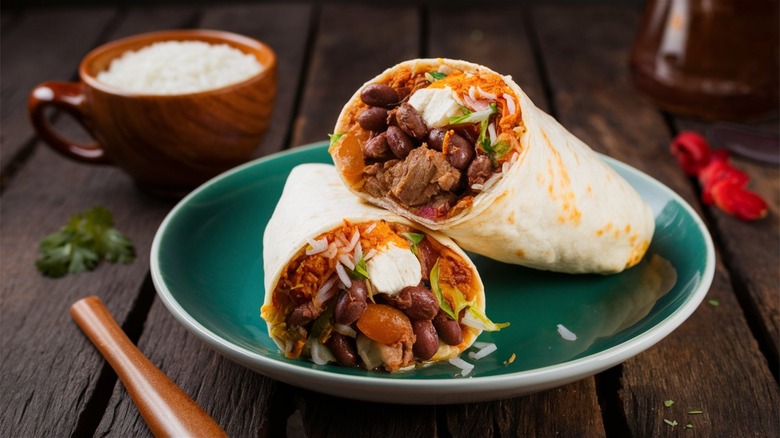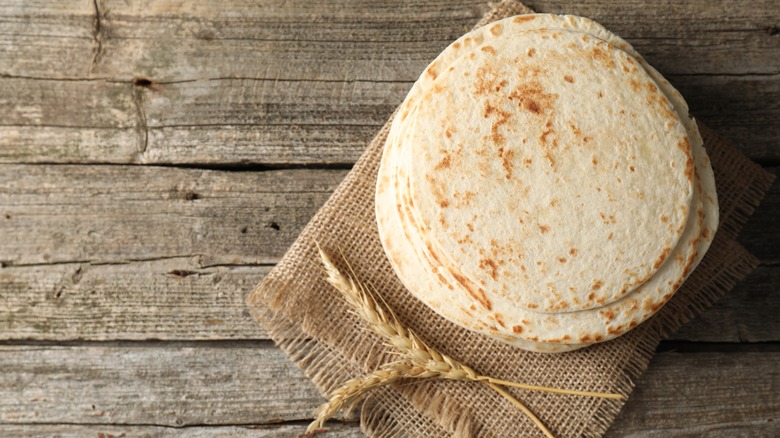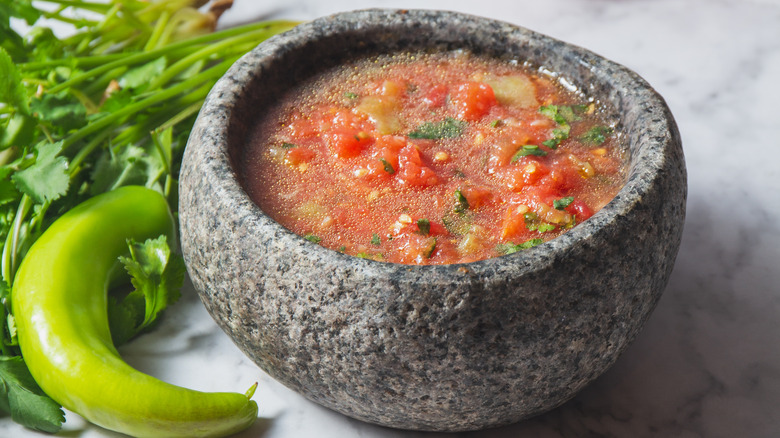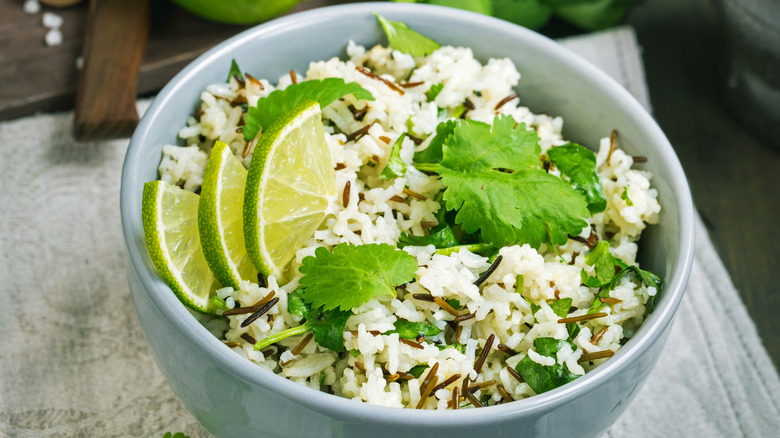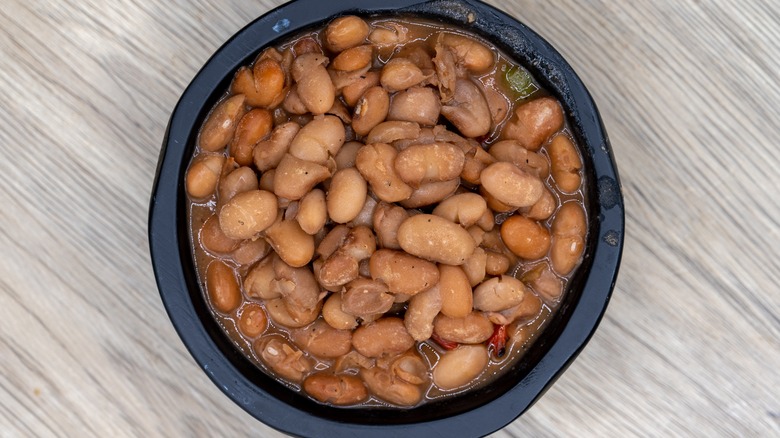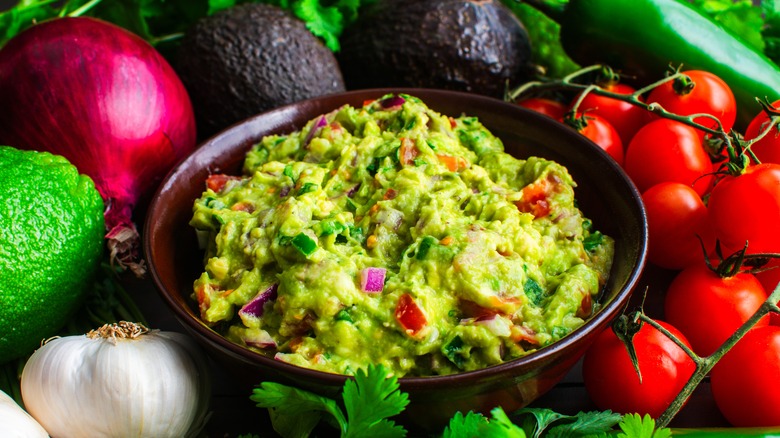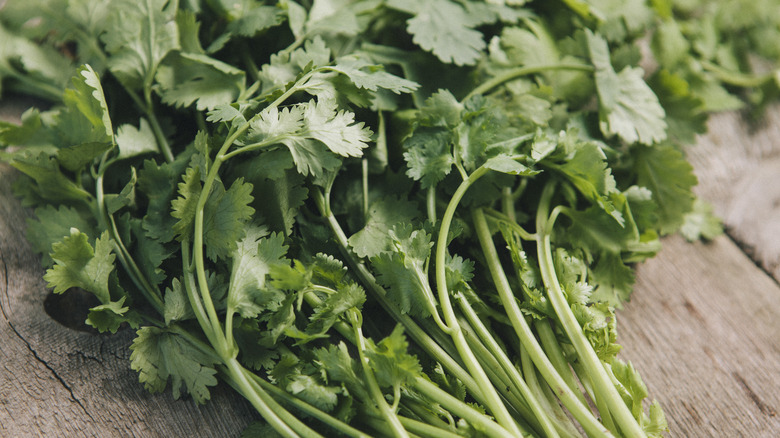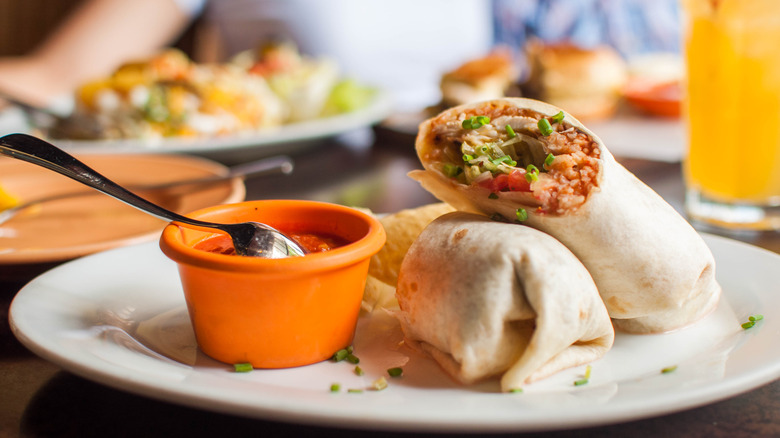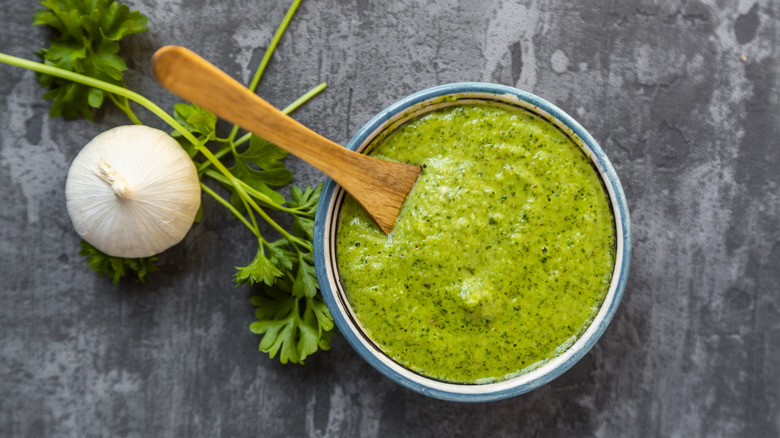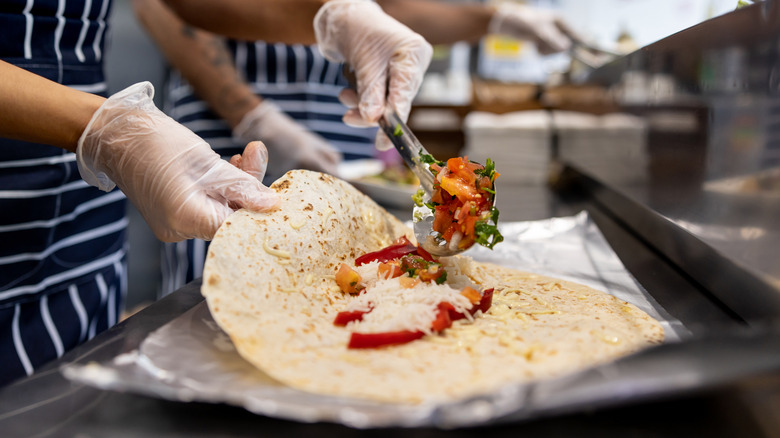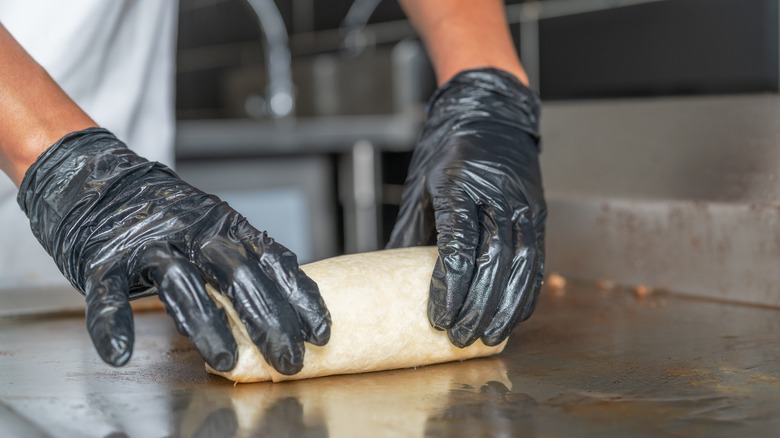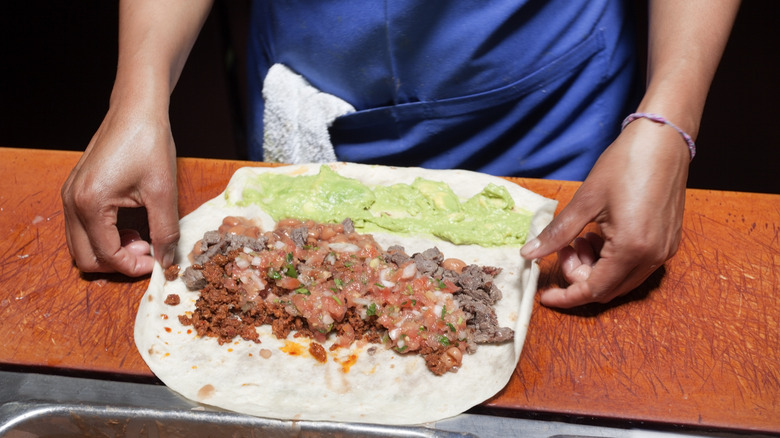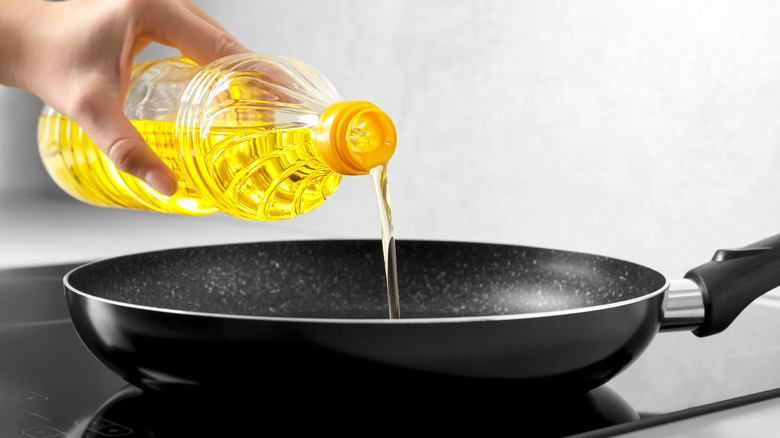Mexican Food Experts Tell Us Why A Restaurant Burrito Will Always Taste Better
Layers of delicious fillings carefully wrapped inside a huge tortilla — it's no wonder we're all a bit obsessed with burritos. But if you've ever had the experience of making your own burritos at home, only to be disappointed with the results compared to your favorite restaurant offerings, you're not alone. The fact is that burritos almost always taste better at a restaurant. Whether it's a sit-down affair or a more casual hole-in-the-wall joint, what you get there is almost always better than homemade.
We're not saying that the burritos we make ourselves are bad. It's just that they don't reach quite that same level of excellence. Often the flavors don't taste as punchy or well-balanced, the beans aren't as creamy and flavorful, and the rice is lacking something.
It's simply not the same as what comes off the menu at our fave restaurants, and we want to know what's going on. So, I spoke to four chefs who specialize in Mexican and Tex-Mex cuisine to understand why burritos always taste better at a restaurant. Not only will this give you some insight about what goes into a great restaurant-quality burrito but it might give you some pointers as to how you can improve your own homemade version.
The tortillas are often handmade or locally produced
When making burritos at home, many people simply pick up whatever brand of tortillas they can find at the store. In restaurants, much more care and attention is taken in making or sourcing this key ingredient. "The tortilla is the foundation." says chef Jonathan Perez of L.A. eateries Macheen and Distrito Catorce. "It needs enough hold and enough flavor and is as critical as the components you add into it." To that end, there are some key questions Perez ponders when sourcing the perfect tortillas — "Does it rip? Can it stretch? Does it elevate the overall flavor?"
Chronic Tacos founder Randy Wyner also appreciates the importance of good tortillas. "Restaurants typically use fresher, higher-quality tortillas, sometimes made locally or in-house," he says. "Our tortillas have a better texture and flavor compared to the mass-produced ones found in average grocery stores, which can be thicker, less pliable, and not as fresh," he adds.
Raul Luis, owner of Birrieria Chalio, explains that even if restaurants don't make their own tortillas in-house or buy them locally, they have access to wholesale suppliers with a wider range of high-quality offerings compared to what you'd find at the grocery store. He says this means restaurants can source tortillas with "different varieties, sizes, textures and flavors." These may be imported from Mexico or made by independent producers that don't sell in most stores. So, when you pick big brand grocery store tortillas, the results just aren't the same.
The salsa is always made from scratch
If you're wondering why your homemade burritos aren't measuring up to those you enjoy at restaurants, the salsa could be to blame. Many people use store-bought salsa for their homemade burritos, while a decent restaurant will always make its salsa in-house. "There is a huge difference between store-bought and salsa made from scratch," says Executive Chef Tacho Kneeland of Cabo Wabo Cantina. "I believe fresh is always better, so I prefer to use local produce to make my salsas from scratch."
"The salsa is what makes a good taco or burrito," states Mexican chef Raul Luis. "Every Mexican restaurant makes their own salsa. They all use special techniques from roasting tomatoes to boiling their jalapeños. Fresh ingredients and different herbs and aromatic spices make a huge difference." He adds that these variations mean you'll never get two identical salsas from different restaurants. A great salsa is a restaurant's calling card — in other words, it's what makes the place and its food stand out and keeps you coming back.
Kneeland also mentions that restaurants can match the salsa to the burrito to improve the dish even further. "By making the salsas in the kitchen, you give yourself the opportunity to create and pair the burritos with the perfect salsa," he remarks. "That is not always an option with something store-bought." Even perfecting an easy salsa recipe will make the difference to homemade burritos.
The rice is seasoned to perfection
Rice is a common addition to burritos. If you're making your own at home, you might just stick in some unseasoned rice or lightly season it with salt, but that's one of the reasons you aren't making something restaurant-quality. Not to mention that there are many mistakes you can make with cooking rice, so you might fall at the first hurdle before you've even seasoned it. By contrast, good restaurants pay close attention to how chefs season their rice, so they aren't wasting valuable tortilla space on something that isn't bringing much to the party.
"At Chronic Tacos, we offer two different types of rice," says its founder, Randy Wyner. "Our Spanish rice includes tomatoes, onions, tomato puree and other Mexican seasonings," he notes. Chronic Tacos also offers a white lime rice that's made with fresh lime juice, cilantro, black pepper and garlic salt. Wyner says his restaurant chain opts for rice "that compliments the other ingredients in the burrito, adding depth and balance."
Chef Jonathan Perez says that the way he seasons rice depends on the type of rice he's trying to make and the fillings that he's pairing it with. "For instance, if we're doing an asada method, I'll probably go with cilantro or oregano rice," he explains. "If we're doing a braids method, I'd probably lean toward Mexican-style," he adds.
The beans are often cooked from dry
More often than not, the beans in your homemade burrito probably come straight from a can. You may then wonder why they're not as good as the beans you've had in restaurant burritos. Well, that's because quality restaurants often cook those beans from dry for a creamier texture and better flavor.
"Many restaurants, including Chronic Tacos, cook beans from dry," says Randy Wyner. "Cooking beans from scratch allows us to control the texture and flavor better. The beans are always cooked with spices and seasonings, which infuses them with more flavor compared to canned beans."
When it comes to beans, "made from scratch is always better," agrees Tacho Kneeland, chef at Cabo Wabo Cantina. "I prepare my beans with onion, garlic, tomatoes and chipotle chiles to bring out as much flavor as possible," he says. So, if you want to make your homemade burritos more like restaurant offerings, it might be time to crack out the dried beans.
There are also other methods for cooking beans before adding them to burritos. Some restaurants use refried beans in burritos and cook them for a second time with additional seasonings. "When we refry our beans, we're adding more flavors to the beans themselves," explains Jonathan Perez of Macheen and Distrito Catorce. "They almost become like a puree that locks in that sought-after profile." You might want to try some expert bean cooking techniques the next time you make burritos at home.
The guacamole is made fresh
Although not every burrito contains guac, it's a common addition that can bring much flavor. It might seem simple — avocado, a bit of lime, some aromatics — but when that guacamole is bad, you'll know it. But, even when it's just mediocre, it can downgrade a burrito from amazing to just okay. At good Mexican restaurants and burrito joints, the guacamole is always made fresh — you won't find any of that store-bought garbage.
"Restaurant-style guacamole is always fresh, and you can definitely taste the difference," remarks Birrieria Chalio chef and owner Raul Luis. "Restaurateurs are more demanding on suppliers to ensure they receive the best crop of avocados, ensuring a better product," he adds.
Luis isn't the only one for whom freshness matters. Chef Jonathan Perez also embraces the advantages of guac that's made in-house, as soon as possible before serving. "The fresher the better for us," says Perez. "Store-bought options aren't as fresh as something we make in-restaurant. And, when we prepare guacamole onsite, we try not to make more than we need since it oxidizes so fast."
Ingredients are also important. "Being from Mexico, nothing compares to the flavor of fresh avocados," says chef Tacho Kneeland. But, the good news is that you can make guac yourself at home if you want to up your burrito game. "The secret to a great guacamole is to not make it too complicated," Kneeland tells us. "Fresh everything — avocados, cilantro, onion, chili, and lime juice. That's it."
Restaurants use fresh herbs and authentic spices
The way that the ingredients in burritos are seasoned in restaurants is a big part of why they never taste the same when you make them at home. "We use a combination of authentic spices, along with fresh herbs," says Randy Wyner. "These add layers of flavor that might be overlooked at home." Just knowing which kinds of seasonings to add can make all the difference. Restaurants may choose whole spices over ground ones, toasting and grinding them in-house for fresher flavors. Fresh cilantro is another common addition you might be missing out on.
If you're seasoning your protein of choice with an Old El Paso sachet or generic grocery store burrito spices, it just can't rival a restaurant burrito. "We definitely develop and use in-house seasonings," Jonathan Perez remarks. "We recently started using Chef Merito [a seasoning brand] for our asada burrito." He adds that it helps tenderize the meat and gives it a pop of flavor. "This is an extra step. But, we're looking for more complexity than salt and pepper — something that takes our protein flavor profiles to the next level."
"There are also many seasonings used by restaurants that are not available to the general public, because of the supply chain," notes Raul Luis. He explains that many of these suppliers aren't household names, as they only supply to restaurants and other food businesses. It could be that your favorite seasoning blend comes from one of these suppliers.
Chefs pay attention to the balance of flavors
Making a great burrito isn't just about packing it full of flavor, but making sure the flavors that you choose balance well with one another. Unless you're a highly accomplished cook, this likely isn't something that comes easy. You might make good burritos, but they won't cross over into greatness without thoughtful flavors.
"We're balancing acidity, heat, tartness," says chef Jonathan Perez. He explains that, in the kitchen, he'll even go as far as to balance the flavors in his guacamole to complement the protein's marinade. That's the kind of attention to detail that the average home cook can often only aspire to. Balanced flavors are among the reasons why sauces are always better at restaurants, as well.
If you're new to balancing flavors, the concept is simple to explain but somewhat harder to put into practice. It's essentially the art of combining flavors so they complement one another. You want a harmonious taste to the finished dish rather than having one ingredient that overpowers the others. In some dishes, you need to make sure there's enough tartness to cut through the umami or salty notes and enough sweetness to balance out these sharp elements. Spice can round off sweetness, while salt enhances it. It's a careful interplay that takes time, practice, and knowledge to get right — so, perhaps that's a major reason why restaurants make better burritos than you can whip up at home.
There is a greater range of sauces and condiments in restaurant burritos
When you make burritos at home, you'll probably stop at salsa and guac — maybe a splash of hot sauce. That's understandable. Most home cooks don't have the time or inclination to throw together five different sauces for one burrito. But, you may find a wider range of sauces and condiments in restaurant burritos that helps elevate them above homemade versions.
"Other sauces like cilantro crema, queso, or various hot sauces (Verde and Roja) can significantly enhance the flavor of burritos," says Randy Wyner of Chronic Tacos. "These sauces add complexity and richness that you might not achieve with standard condiments at home." You might find a chimichurri sauce packed with fresh herbs in a restaurant burrito or even something as simple as Sriracha mayo. These mixes don't have to be complex, but can still bring an extra layer of flavor. Depending on the consistency, many sauces layered near the top of a burrito should sink through other ingredients and evenly distribute itself, meaning you get great flavor with every bite.
What's more, there are a range of burrito styles that you might not have even heard of. These may use different sauces from your average burrito. So, if you go to a restaurant and try a wet burrito, for instance, it'll come with a red sauce, a bit like an enchilada sauce. Getting your head around which sauces go with which burrito types is a real game-changer.
Expertise and experience plays a role
Why do burritos taste better at a restaurant? Simply put, you're not a chef who has extensive culinary training or experience, and who potentially makes hundreds of burritos every week. You just can't compete with that kind of expertise, and that's why your homemade burritos are unlikely to ever surpass those from a high-quality restaurant.
"The combination of ingredients and knowledge of the kitchen staff is ultimately what makes restaurant burritos taste better," explains chef Tacho Kneeland. This is what chefs do for a living, after all, and if you choose your burrito joint carefully, they're darn good at it.
"The overall experience at a restaurant also plays a role," Randy Wyner adds. "The expertise of the chefs, the quality of the ingredients, and the attention to detail all contribute to a superior burrito. Additionally, the environment and the care put into each step of preparation make a big difference." The best chefs have put in the hours to learn how to make a great burrito and care about their craft, both of which hugely impact the outcome.
Restaurants often have cooking equipment that you wouldn't find at home
If you get a peek into a restaurant kitchen, then you'll quickly notice that commercial kitchens have seriously different cooking equipment compared to what's in your home kitchen. "The cooking, whether on a seasoned griddle, charbroiler, or wood-fired grill, all create different taste profiles that cannot be duplicated at home," explains Mexican chef and restaurateur Raul Luis.
In some cases, this can make a huge difference, such as when an ingredient is smoked in-house or charbroiled. In other cases, it might add something small, such as a burrito that's finished on a griddle in order to crisp the exterior. However, combined with additional factors — such as fresh herbs and quality homemade salsa — even seemingly minor differences could still be enough to make the finished dish taste special.
"Restaurants have the cooking equipment to ensure that each burrito is made at the correct temperature," Luis adds. Again, this could be the small variation that ends up making a next-level burrito. Sometimes these little things make all the difference.
Unfortunately, you can't do much about this unless you want to deck your kitchen out with professional equipment. As far as most home cooks are probably concerned, this is overkill in pursuit of a better burrito. Still, you could take a extra steps to approximate the above, such as grilling certain ingredients over charcoal or investing in a stovetop smoker.
Good restaurants actively improve and perfect burrito recipes
It's a harsh fact of the culinary world that a restaurant diners don't want to return to will go out of business quickly. So, chefs and owners have every incentive to constantly improve their recipes. Plus, good chefs love their craft and want to make the best food possible. Have you ever made and remade the same salsa hundreds of times, making small tweaks until it's perfect? We didn't think so. But the best chefs who are dedicated to their work certainly do.
"At our restaurants we want the customer to keep coming back, and we're not just competing against other venues, but folks prepping their meals at home," Jonathan Perez remarks. "So, we work to showcase our full culinary ability and our flavor notes. We want you to taste and appreciate each component in every bite."
"Restaurateurs are always looking for ways to make their food better, and having access to unique and fresh ingredients, as well as certain equipment, allows them the opportunity to perfect their burrito making," says Raul Luis of Birrieria Chalio. "They also have the experience factor, having to cook and sell tens or hundreds of burritos a day. This gives them a major incentive to create the perfect burrito." So, until you put a similar level of effort into making every component of your burrito recipe perfect, you just won't be able to compete with what's on offer at a good burrito restaurant.
There's usually more fat in restaurant burritos
One of the reasons why restaurant burritos taste better than homemade is that chefs are often more liberal with their use of fat than home cooks. This isn't a criticism; it's just a fact. Fat carries flavor and therefore higher-fat foods often taste better.
"Restaurants will always use more oils and fats," says Tacho Kneeland. "It does help enhance the flavors of the ingredients," he adds. Jonathan Perez has another way of using fat to enhance flavors: "at the restaurants, we'll use oil or butter to help us capture that crispiness on the outside of our tortillas when we grill them," he tells us.
So, you don't necessarily need to be afraid of fat. We bet that some of the best burritos in the U.S. are made with ample oil and other fats. It's an easy way to boost the flavor and, as long as you aren't eating burritos every night, it's fine to occasionally be heavy-handed with it.
